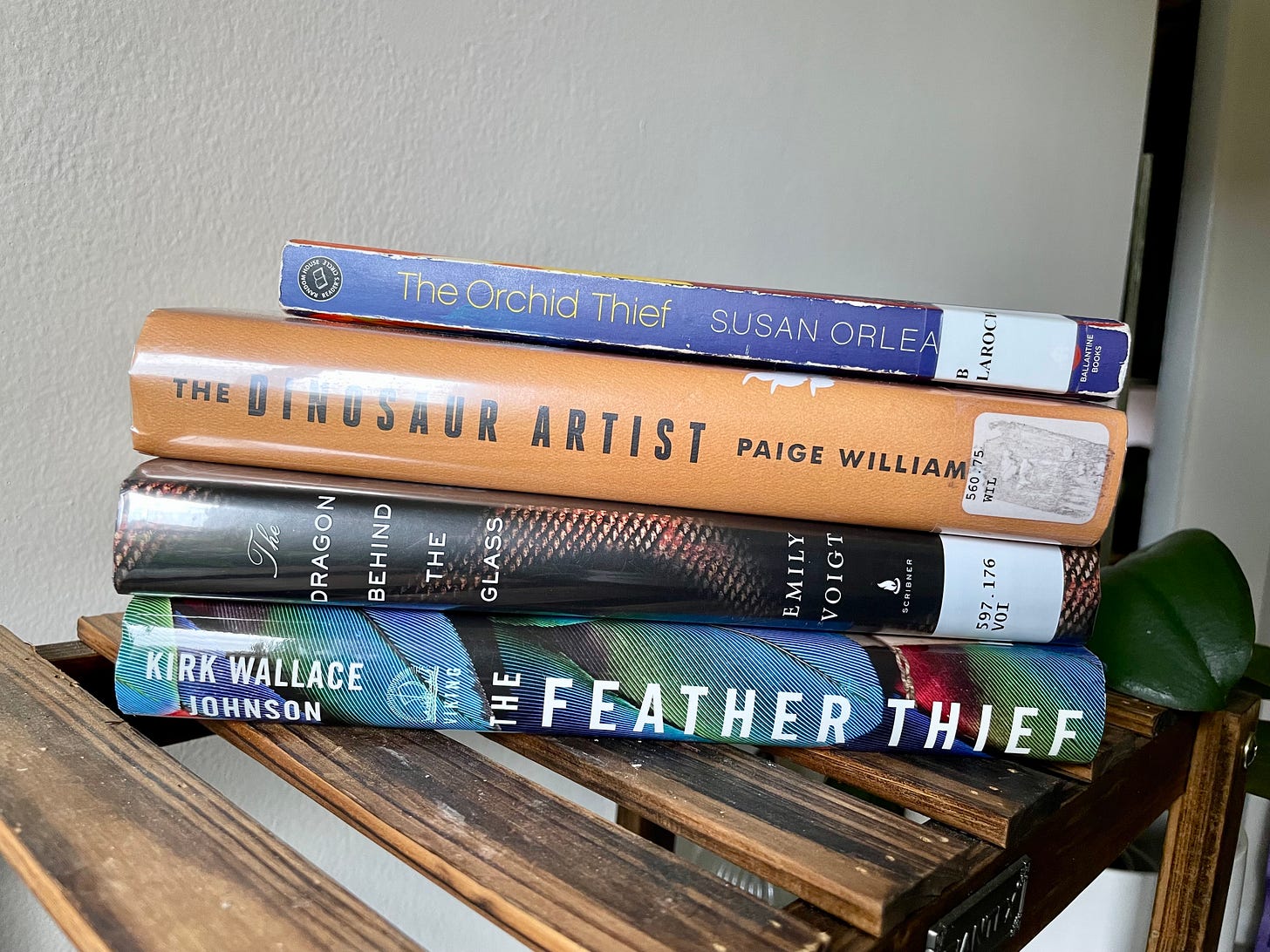Recommended for: people interested in fossils, history of paleontology, smuggling, Mongolia (past and present), thrilling crime stories
Background sounds: This gravel sounds ASMR is reminiscent of the soft brush of carefully extracting a fossil from desert grounds before you smuggle it out of the country.
What to eat: reliable yet a little unexpected, chocolate chip cookies spiked with rosemary are a perfect accompaniment
If you like this, you may also like: Although i will mostly focus on “The Dinosaur Artist,” i have also included a round-up of other natural science true crime books i’ve enjoyed over the years. “The Feather Thief” by Kirk Wallace Johnson; “Dragon Behind the Glass” by Emily Voigt; and “The Orchid Thief” by Susan Orlean
Additional dinosaur law information: “Dinosaur 13,” a documentary about Tyrannosaurus Sue, yet another intriguing case involving dinosaur law. In case there are any lawyers reading, you may be interested in this filing from the court case of United States v Eric Prokopi
How to seek knowledge while getting lost in a story? How to reconcile the thrilling nature of true crime with the abhorrence of real pain? I have found the answer to both those questions in one of my favorite genres:
Natural science true crime. The drama of court cases and arrests without the loss of life. Instead of marginalized people subjected to over policing, it’s often wealthy, often white people who end up behind bars. There are tons of interesting facts about scientific discovery and the natural world, roiling together with page-turning criminal intent. Delicious and reliable.
The Dinosaur Artist
by Paige Williams
Although this book spans fossil collecting throughout the ages, the past and present of Mongolia, history of the Tucson Gem Show, and a brief overview of laws governing fossil ownership over the world, the plot running through “Dinosaur Artist” is about fossils. A particular fossil. Tarbosauros bataar. Alarming reptile hero, as if a Russian scientist saw the Mongolian word “baatar,” meaning hero, and then spelled it wrong. See, in the United States, if i found a fossil on my land, i could legally do whatever i wanted with it: destroy it, sell it overseas, donate it to a museum, grind its bones to make my cookies. It is one of the few countries with such generous laws surrounding fossil ownership. But T. bataar isn’t found in the United States; it has only been found in the Gobi Desert of Mongolia, which has significantly stricter dinosaur law. A fossil found in Mongolia cannot legally leave Mongolia without the permission of Mongolian scientists. Permission has been granted many times for fossils to be studied by paleontologists in labs with better equipment, or loaned to museums with more stable environs, but not for private sale to private collectors. So it was frankly a bit ballsy for Eric Prokopi, professional fossil hunter, and Heritage Auctions, a California based auction house, to blatantly advertise the auction of a Mongolian dinosaur species.
Whether it’s wealthy gentlemen scientists paying pennies and writing papers on Mary Anning’s dangerous discoveries, or Eric Prokopi following the footsteps of countless Americans parading through the Gobi Desert, this story says more about the push and pull of money vs. knowledge than it does prehistoric creatures themselves. Once you chip away the surrounding sands, “The Dinosaur Artist” begs the question: what responsibility do we have to preserve natural history, and how should that responsibility be enforced?

“The Dinosaur Artist” also calls up another desire: treasure. Many of the fossil hunters described in the book are driven not solely by money or knowledge, but by the ancient urge to poke through the earth and find something unique, to own something no one else has. It isn’t enough to witness treasure; man wants to possess it. Strange, how a creature who would have no trouble snacking on your noggin, could be caught up in the politics between nations who claim lands that didn’t even exist when the creature lived and died, all so that wealthy people could display its body in their homes.
Fast facts:
Tarbosaurus bataar was originally Tyrannosaurs bataar, before it was determined to have enough differences from earlier described Tyrannosaurs to warrant separate identities It is called “bataar” because Evgeny Maleev spelled the Mongolian word “baatar” incorrectly. So i guess that makes two of use who are not so good at spelling.
Peter the Great, the Russian king, would order impromptu tooth extractions from people he met on the street to add to his menagerie, which formed the foundation of what is now the Russian Academy of Sciences.
The first democratic election in Mongolia was held in 1990, with 98% of citizens participating, some arriving to the polls on horseback.
Mary Anning was a professional fossil hunter in the first half of the 19th century. She was uneducated and a woman, which means gentlemen scientists were happy to write papers on her discoveries without so much as mentioning her name. She worked along the Jurassic Coast of England and is responsible for discovering three separate species of Plesiosaurus, cephalopod ink chambers, and the shark-ray Squaloraja polyspondyla, which helped prove that species go extinct. Here is a link to her wikipedia page.
The Feather Thief: Beauty, Obsession, and the Natural History Heist of the Century
by Kirk Wallace Johnson
Background sounds: You don’t need to become obsessed with a Victorian hobby to enjoy some relaxing Norwegian river sounds.
This book reads like a thriller, peppered with interesting information that answer all your burning questions about the world, such as: How did the expansion of the railway system lead to the theft of a million dollars worth of dead birds from a British museum? Other topics include: the amateur who came up with the theory of evolution, before or at the same time as Darwin depending on who you ask; Victorian curio cabinets; and fly fishing.
Dragon Behind the Glass
by Emily Voigt
Cookie variation: Replace the chocolate chips and rosemary with coconut flakes and dried cherries or cranberries to give them a “rare red Arrowana scales” vibe
It’s been years since i read this, but i attribute the downfall of my years long aquarium hobby to this book. A little less true crime and a little more investigative journalism, but i’m including it anyway cos of all the smuggling. This focuses mostly on the exotic pet trade, as the author seeks out the elusive Arrowana, once prolific in the wild rivers of Asia and South America.
The Orchid Thief
by Susan Orlean
If you like this, you may also like: Please watch the movie “Adaptation,” starring Nicholas Cage, and written by Charles Kaufmen, and directed by Spike Jonze. For optimal viewing, read the book first.
While “Dragon Behind the Glass” was a heavy contributor to me giving up my aquarium hobby, The Orchid Thief got me into (surprise) orchids. Happy to report that my Oncidium “Sharry Baby,” whose flowers smell like chocolate, is about to bloom for the fourth time. If you have any interest at all in this history of Floria or botanicals, you will enjoy this book.
The Recipe
This is based on one of my favorite cookie recipes, from one of my favorite cookbooks (and the one i most often recommend to people interested in veganism): Isa Does It by Isa Chandra Moscowitz.
Ingredients:
1/2 c vegan butter
2 tbs chopped fresh rosemary
1/3 c brown sugar
1/4 c sugar
1 tbs ground flax
1 tbs vanilla
1 1/3 c flour
1/2 tsp salt
1/2 tsp baking soda
1/2 c chocolate chips
Heat oven to 350 F.
Beat together butter, rosemary, and sugars. Add flax and vanilla. Add about half the flour, baking soda, and salt. Mix, then add the rest of the flour. If it looks too dry, you can add up to 1/4 c vegan milk. (Different brands of vegan butter have different moisture contents, which affects this). Stir in the chocolate chips.
Scoop about 2 tbs per cookie onto a greased baking sheet. Bake for 10 minutes.
Dragon Behind The Glass variation: omit rosemary and chocolate chips. Add 1/2 tsp almond extract, a handful of slivered almonds, and a handful of dried cranberries or cherries.
Thanks for reading Cake and Cynicism. You can subscribe for free below. If you want to read the books i suggest, you can check out your local library or independent bookstore.







Wow, Blake! This is the first entry of yours I've ready and I am fairly well blown away. In the last 8 minutes I have: learned many things, developed a hankering for more of these cookies (can confirm, they are terrific), questioned my relationship to aquariums and added several books to my "want to read" list. Thank you for the fine writing and baking!
But are dinosaur bone cookies vegan???